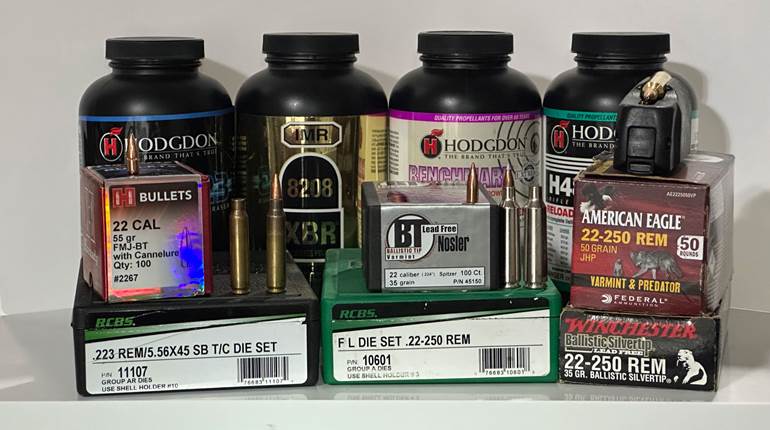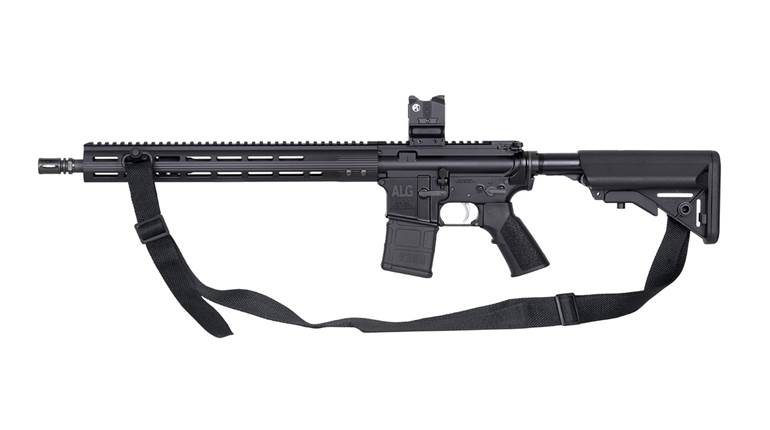
One of today’s best-known and most respected trainers in the art of gun fighting, retired Sgt./Maj. Kyle E. Lamb, spent more than 21 years with the U.S. Army—more than 15 years of which were in Special Operations. Lamb is one of those who has “been there and done that”—including combat operations such as the infamous “Blackhawk Down” incident in Mogadishu, Somalia, and throughout numerous tours in Iraq and Bosnia. He currently operates Viking Tactics as a military, law enforcement and civilian trainer teaching courses in tactical entry and the use of the carbine, among others.
Lamb is an unassuming individual who has the appearance of an “average Joe,” but when it comes to kitchen-table discussions about the effectiveness of the general-purpose rifle—in today’s guise, the AR carbine—for use in a home-defense scenario, he is anything but. That’s why we decided to sit down with him for a question-and-answer session on exactly that topic. Here’s what he had to say.
AR: Kyle, we know you’re passionate about the AR because it’s the platform you’ve relied on for years to see yourself through some desperate situations. What runs through your mind when you hear people with significantly less fighting experience than yourself opine about the AR’s unsuitability or deficiencies in the role of home/self-defense?
KL: Several folks have come forward in recent years to spout gallantly the mental deficiencies of those who would choose the “general-purpose rifle” for home defense.
Well, I may have been hit on the head a few too many times, and I have been in very close proximity to large explosions, but I personally stand in support of the AR-15 chambered in 5.56x45 mm NATO/.223 Rem.
The catch with many magazine articles, Internet postings and gun shop discussions is not the fact that folks want to select a different system for the defense of their home—as an unbending supporter of the Second Amendment I am in favor of whatever you prefer, are comfortable with, or can afford. The rub comes when folks tell me that mine is a poor choice and cite reasons that cannot be supported by fact.
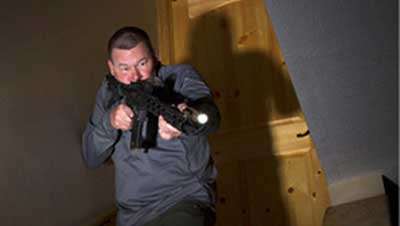
AR: So, what is it about the AR that makes it so suitable, in your opinion, for a home-defense scenario?
KL: The AR is very easy to shoot. Head out to the range and test my theory. Ask anyone who wants to join in on the fun to try shooting a scored event, under pressure, with a pistol at home-defense ranges. After you see their performance, try the same with an AR, I will bet money you see much better control of the system. Men and women alike just shoot better with a carbine than with a pistol. As long as the carbine is light enough for the shooter to handle properly, the learning curve will be straight-up.
The AR is unbelievably versatile, from contact shooting distances out to 300 yds., the carbine will outperform the pistol. Most of us don’t think of 300-yd. shooting as a likely home-defense scenario, and, in many areas, it wouldn’t be. But if given an option of defensive tools, and considering our country’s independent heritage and past experiences, why wouldn’t you want extended-range capabilities?
AR: What about other choices, such as the shotgun, for home defense?
KL: For self-defense, a reliable semi-automatic is king. That is why I would not pick the shotgun. Rarely can you find a semi-automatic shotgun that is 100-percent reliable with assorted ammunition. Add the fact that you may need to shoot without your shoulder to the buttstock and reliability with the scattergun drops even more. Recoil-operated semi-automatic shotguns are light and handy but unreliable when not held tightly, and gas-operated guns are heavier than I prefer for a home-defense scenario. Once again, if you want to carry a shotgun for home defense, knock yourself out. I choose not to do so. I am sure those who carry pump shotguns will chime in with the absolute final word on the proper pick for the home-defense shotgun—all I ask is that you head to the range and try to operate your pump gun with only one hand. Simulating a disabled arm will make you a believer in the semi-automatic carbine. The shotgun is also extremely deficient in magazine capacity. Once again, the AR shines in this category. Even in 10-round-maximum states, in which long-gun rights have been destroyed, you have more firepower than with most shotguns.
AR: Considering its portability and maneuverability, wouldn’t the pistol be the best choice for home defense?
KL: If you are among those who say, “If I can’t fix the problem with my eight rounds of .45 ACP, it can’t be fixed,” I say please grab a big old mug of black coffee and wake up from your dream. No one knows who, what, when, where or why the fight will start—blowhard statements only degrade an intelligent conversation.
Once again, focusing on reality, 5.56x45 mm NATO ammunition just plain works. There are literally thousands upon thousands of terrorists who have met their ends because of it. Apparently, they did not have a chance to read the latest gun blog decrying the lack of stopping power from the 5.56.
“Pistols point faster,” is a common proclamation, and it can be true if you already have your hands on the gun. However, the last part of that statement is often overlooked: “Pistols point faster, and miss more often.” Although we can quickly get the pistol into the fight, the carbine will get there and be more shootable for the average person. With a carbine in the low-ready position, the average shooter can get shots on target in less than one second. Of course, that is the reaction time once you have made the determination that you should, in fact, shoot. It does not take into consideration the fact that you will have to work your way through a decision-making process that includes threat identification.
AR: What else has your experience as a trainer taught you about why the AR seems to be so effective for so many users?
KL: The AR has little to no recoil. Even when fired from a strong- or support-hand-only position, its recoil is negligible. Pistols and shotguns recoil far more than most .223 carbines. Less recoil means more time on target—that is a good thing when the shooting starts. Another concern I hear is the carbine’s noise level. Ok, you got me, and you are correct. Guns are loud, and ARs are really loud. But .40 S&W pistols and shotguns are really loud, too. If you feel this is a serious concern for home defense there are a few ways around the extra sound. For instance, have you considered a suppressor? They are legal to own in many states, and with their threaded muzzles, most ARs are “suppressor ready” as is. Also, suppressors are available from more and more manufacturers in recent years at reasonable prices.
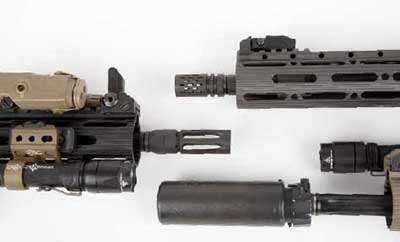
AR: Isn’t sight acquisition slower and more difficult with a carbine than with a handgun?
KL: With a red-dot or low-power scope on your carbine you won’t need to align sights as you would need to with your pistol. Simply keep both eyes open, place the red dot on the threat and squeeze the trigger. I am not trying to oversimplify the process, but in reality it will be easier to stay proficient with a red-dot mounted on the carbine than iron sights on a pistol. That’s not a guess, it’s a fact.
AR: Isn’t there a risk of over-penetration with a carbine versus a pistol?
KL: When it comes to over-penetration you will have to determine what is acceptable. You must make the decision, no one will be there to hold your hand and give guidance as to whether or not you should shoot. You will have to make the call. If you are using ammunition that stops in one layer of sheetrock, it will likely have trouble reaching the vitals of an assailant. In all actuality, if you have children in the next room, you’d better not miss. A shot from a pistol, shotgun or the AR will all easily penetrate a conventionally constructed wall consisting of sheetrock, wooden studs and possibly insulation.
Statements are made that the shotgun or pistol should be used because of the over-penetration problem with 5.56 carbine ammunition. This could not be further from the truth. If you conduct a little research you will find that numerous law enforcement departments, to include the FBI, have proven this to be false in most cases. The fact of the matter is that many of these bullets will penetrate numerous walls, but standard 5.56 loadings are the least of your worries when compared to pistol and shotgun fodder, which continue to take top honors in the category of over-penetration.
AR: Are there other considerations or concerns that people should be aware of when looking at the AR as a primary home-defense tool?
KL: Absolutely. The ease with which you can transport a carbine in and around the battlefield is one of the reasons I immediately gravitate to it for home protection. When the battlefield is your domicile, the only real difference between Iraq and Home Town, USA, is the distances you may need to engage. Most civilians won’t have to shoot 400 yds. at enemy insurgents, but it never hurts to be prepared.
Figuring out exactly how to wear a pistol can be problematic. A reasonable setup would be a pistol belt with holster and magazines standing by for you to strap on. This can be easily stashed conveniently beside or under your bed. Pistol, pistol ammunition, rifle magazines, flashlight and basic medical gear intact, this will help with the employment of the carbine, but I digress. With the carbine, though, a simple two-point sling is all you need to have the ability to go hands-free. Grabbing the carbine, if needed, is quick and safe.
Another consideration to keep in mind when you do head to the range with your AR is offset. Offset is the difference between your line of sight and the bore axis, which typically causes you to shoot low at contact, or close-quarter, distances. When I say low, I am talking about 2½" if your carbine is zeroed for 50 or 100 yds., but you are engaging a threat at 3 to 5 yds. As the target moves away, your point of impact will move closer to your point of aim. This may take a little thinking, but as soon as you fire your first few training rounds within room-size distances you will be well aware of the need to hold for offset.
AR: OK, let’s say, just for the sake of argument, that you’ve convinced us the AR is the best tool for home defense. What are a couple of specific things—drills or features—that someone should strive for when setting one up?
KL: Since I did say the semi-automatic is king, I must delve into this a little bit further. No matter the system you choose, you should spend time on the range fighting through the loading, stoppages and shooting positions with the use of only one arm. This isn’t easy, but it can be done. Most general-purpose rifles will work perfectly when fired with only one hand. While you are at it, try shooting with your support-side eye as well.
When it comes to capacity, I have been in situations where not only did I want an AR, I wanted 30 rounds loaded in my magazines. Not 28, but 30. I know that violates an unwritten code of tactical efficacy, but I can attest to the fact that most U.S. Army elite counter-terrorist commandos load 30 rounds per magazine. Disregard the naysayers and their minimalist-capacity mindset. Live in the real world.
Some who employ the AR for home defense have told me they like to store the carbine with a 20-round magazine in place. I agree this does make the carbine a little easier to store, but make sure you have quick access to a 30-rounder when the shooting starts.
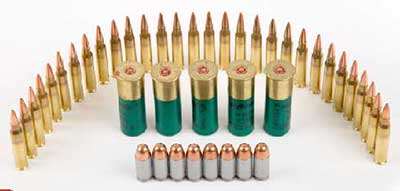
AR: Does the fact that we’re now relying on a more powerful arm for home defense mean that we don’t have to be as precise in our application of its greater power? And what about ammunition selection?
KL: When it comes to terminal performance, shot placement is key, be it with a shotgun slug, .45 caliber pistol, .50 cal., or 5.56 mm bullet. If you want to be effective, you must hit the central nervous system to get immediate debilitation of your enemy. Much ado has been made of the performance of the .223, and I must say picking the right ammo is key. I prefer the Hornady GMX bullet loaded by Hornady or the Barnes TSX bullet which is available in loaded form from Black Hills Ammunition and Remington. These bullets are solid with an open tip and no lead core. They perform well against barriers as well. If you envision any scenario that involves you shooting through automobile windshield glass I would highly recommend this type of projectile.
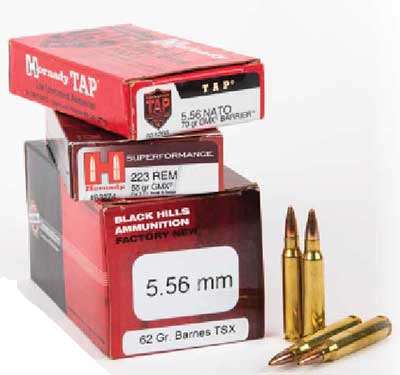
With the AR you can also make changes to ammunition selection quickly by changing magazines. This is especially important to military and law enforcement personnel but sometimes affects civilians as well. You can easily keep lighter weight bullets that limit any potential over-
penetration with the option to change to heavier barrier-blind bullets if special performance is required.
AR: What kind of training do you recommend that people pursue, and are there any specific tips that you can provide here that would elevate the average person’s rifle-handling capabilities?
KL: Since some say the pistol is faster, you will have to head to the range and work a little on your presentation with the rifle. In no time at all you will be making first-round hits in less than a second. It is also important that you think through the decision-making sequence that will lead to your “shoot” or “don’t shoot” resolution. More time will be used thinking through options and analyzing those options. Try to go with scenario-based training as often as you can. With a little practice, the rifle becomes extremely easy to point quickly at a target, confirm sights and engage.
AR: We’re getting the sense that you see handling a long gun as something that should be entirely integrated with the shooter’s physical dynamics and surroundings. Is that right?
KL: Yes. And you’ll see that, once you become familiar with the carbine on the range, movement is a must.
When working on your movement techniques in tight quarters, always keep the muzzle of the carbine down as you make your quick turns. Having the muzzle down is much safer and will also be quick since you are pivoting on the rifle and driving the carbine to the target once the turn is complete. Practice every possible turn, especially starting with your back to the target. I always try to step forward into the fight, if I step backwards there is a good chance stumbling will lead to sitting on your butt—not cool in a gunfight. As to retention of your firearms in a conflict, the pistol and rifle are pretty safe in your retention position as long as you use good technique. If you get lazy, the ability of the bad guy to take away or at least deflect your carbine or pistol off target is a real potential threat. When you use the carbine for home defense, keep your support hand forward to help with leverage for driving the muzzle from target to target, this will also give you the needed strength to maintain control in a gun-grab scenario.
AR: What are a few last-minute tips for getting the most out of our time at the range and knowing whether we have the right gun?
KL: When you do get range time, make good use of the time. Don’t just stand at the 5-yd. line conducting drills the entire day. Use smaller targets, increase the distance and push yourself to quickly get the rifle on target. Once on the rifle, confirm that the red dot is aligned with your intended hold-off point or offset adjustment point and squeeze the trigger. Repeat as necessary. The end state will be building confidence that you have the ability to use your carbine effectively in a fight if the need should ever arise.
When you leave the range, make sure you have ammunition that not only performs terminally but also operates flawlessly in your carbine. If your carbine is not 100-percent suited for you, it shouldn’t be the gun you choose for the fight. Do what is necessary to reconfigure your gun or get one that is perfect and never look back.
AR: What final thoughts would you like to leave us with regarding the AR for home defense?
KL: When it comes right down to it, this discussion is about using what you are most comfortable and extremely confident with. Once again, for me that happens to be the AR, chambered in 5.56x45 mm NATO/.223 Rem. What’s in your closet?













